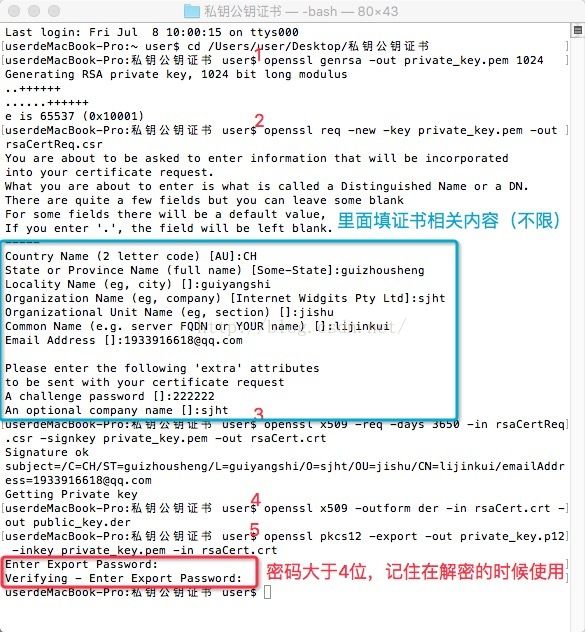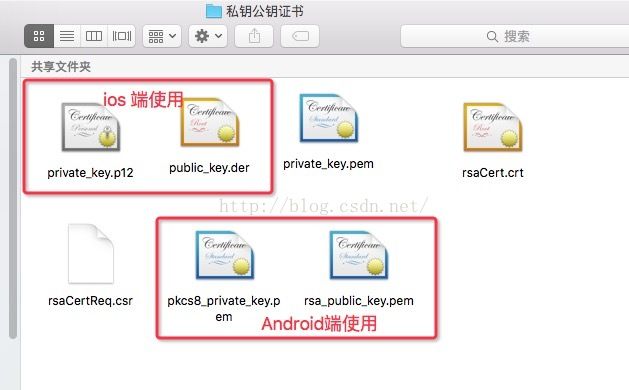iOS RSA加密和解密
MAC OS自带了OpenSSL,而不需要像支付宝sdk中的RSA加密写许多代码,而且有些好事看得不太懂的代码。下面将介绍用Mac终端5句指令生成证书
一、使用openssl终端指令生成公钥和私钥证书,最后需要得到公钥证书(public_key.der)和私钥证书(private_key.p12)这两个证书供iOS端加、解密使用。(rsa_public_key.pem)和(pkcs8_private_key.pem)这两个供Android端使用,这些证书是从同一个私钥证书(private_key.pem)中导出的。Android端的加密数据,可以在Android和iOS端都可以解密,iOS端加密的数据,可以在Android端和iOS端解密。
1,打开终端前,在桌面新建文件夹 私钥公钥证书(用来存放证书)
2,打开终端cd到"私钥公钥证书"文件目录(在cd后空格直接拖文件到终端)回车
3,依次输入下面的指令:(注意:在输入第二句指令的时候,会出现填写一些和证书相关的内容,可随意填,主要是密码要记住。)
// 生成RSA密钥对 1024可换成2048增加安全性
openssl genrsa -out private_key.pem 1024
// 创建认证需要的文件:rsacertreq.csr
openssl req -new -key private_key.pem -out rsaCertReq.csr
// 创建使用X509:rsacert.crt认证,3650是证书有天数,这里表示是10年
openssl x509 -req -days 3650 -in rsaCertReq.csr -signkey private_key.pem -out rsaCert.crt
// 创建公共public_key.der
openssl x509 -outform der -in rsaCert.crt -out public_key.der
// 创建private_key.p12 文件。请记住你的密码
openssl pkcs12 -export -out private_key.p12 -inkey private_key.pem -in rsaCert.crt
运行后的终端:
下面两句指令是生成Android端证书文件的指令:
// 导出公钥pem文件
openssl rsa -in private_key.pem -out rsa_public_key.pem -pubout
// 导出私钥文件
openssl pkcs8 -topk8 -in private_key.pem -out pkcs8_private_key.pem -nocrypt
生成的证书如下,最后使用的就是红色框中(iOS端使用)的两个,注意保存好自己的私钥:
证书已生成完成
二、实现rsa加密解密
1,把上面截图中的两个证书直接拖到工程中
2,添加系统安全框架:Security.framework (Build Phases->Link Binary With Libraries() 点击+号,搜索最后Add)
3,添加加密,解密代码文件免费下载:下载,下载完成后解压,解压的到的文件导入工程,导入时选择:
4,导入头文件:#import"RSA_Encryptor.h"
// 获取证书,加密
RSA_Encryptor *rsa = [[RSA_Encryptor alloc]init];
// 加密
NSString *publicKeyPath = [[NSBundle mainBundle] pathForResource:@"public_key" ofType:@"der"];
NSLog(@"证书路径 key: %@", publicKeyPath);
[rsa loadPublicKeyFromFile:publicKeyPath];
NSString *securityText = @"调试 ~";
NSString *encryptedString = [rsa rsaEncryptString:securityText];
NSLog(@"加密: %@", encryptedString);// 解密
[rsa loadPrivateKeyFromFile:[[NSBundle mainBundle] pathForResource:@"private_key" ofType:@"p12"] password:@"证书密码"];
NSString *decryptedString = [rsa rsaDecryptString:encryptedString];
NSLog(@"解密: %@", decryptedString);如果只加密,不解密,会出现如下崩溃情况:
package com.modules.Encryptor;
import java.io.BufferedReader;
import java.io.FileReader;
import java.io.IOException;
import java.io.InputStream;
import java.io.InputStreamReader;
import java.security.InvalidKeyException;
import java.security.KeyFactory;
import java.security.KeyPair;
import java.security.KeyPairGenerator;
import java.security.NoSuchAlgorithmException;
import java.security.SecureRandom;
import java.security.interfaces.RSAPrivateKey;
import java.security.interfaces.RSAPublicKey;
import java.security.spec.InvalidKeySpecException;
import java.security.spec.PKCS8EncodedKeySpec;
import java.security.spec.X509EncodedKeySpec;
import java.util.ArrayList;
import java.util.List;
import javax.crypto.BadPaddingException;
import javax.crypto.Cipher;
import javax.crypto.IllegalBlockSizeException;
import javax.crypto.NoSuchPaddingException;
import sun.misc.BASE64Decoder;
import sun.misc.BASE64Encoder;
public class RSAEncryptor {
public static void main(String[] args){
String privateKeyPath = "/Users/Isaacs/Desktop/RSA_KEYS/rsa_public_key.pem"; // replace your public key path here
String publicKeyPath = "/Users/Isaacs/Desktop/RSA_KEYS/pkcs8_private_key.pem"; // replace your private path here
RSAEncryptor rsaEncryptor = new RSAEncryptor(privateKeyPath, publicKeyPath);
try {
String test = "JAVA";
String testRSAEnWith64 = rsaEncryptor.encryptWithBase64(test);
String testRSADeWith64 = rsaEncryptor.decryptWithBase64(testRSAEnWith64);
System.out.println("\nEncrypt: \n" + testRSAEnWith64);
System.out.println("\nDecrypt: \n" + testRSADeWith64);
// NSLog the encrypt string from Xcode , and paste it here.
// 请粘贴来自IOS端加密后的字符串
// String rsaBase46StringFromIOS =
// "nIIV7fVsHe8QquUbciMYbbumoMtbBuLsCr2yMB/WAhm+S/kGRPlf+k2GH8imZIYQ" + "\r" +
// "QBDssVLQmS392QlxS87hnwMRJIzWw6vdRv/k79TgTfu6tI/9QTqIOvNlQIqtIcVm" + "\r" +
// "R/suvydoymKgdlB+ce5/tHSxfqEOLLrL1Zl2PqJSP4A=";
//
// String decryptStringFromIOS = rsaEncryptor.decryptWithBase64(rsaBase46StringFromIOS);
// System.out.println("Decrypt result from ios client: \n" + decryptStringFromIOS);
} catch (Exception e) {
e.printStackTrace();
}
}
/**
* @param publicKeyFilePath
* @param privateKeyFilePath
*/
public RSAEncryptor(String publicKeyFilePath, String privateKeyFilePath) throws Exception {
String public_key = getKeyFromFile(publicKeyFilePath);
String private_key = getKeyFromFile(privateKeyFilePath);
loadPublicKey(public_key);
loadPrivateKey(private_key);
}
public RSAEncryptor() {
// load the PublicKey and PrivateKey manually
}
public String getKeyFromFile(String filePath) throws Exception {
BufferedReader bufferedReader = new BufferedReader(new FileReader(filePath));
String line = null;
List list = new ArrayList();
while ((line = bufferedReader.readLine()) != null){
list.add(line);
}
// remove the firt line and last line
StringBuilder stringBuilder = new StringBuilder();
for (int i = 1; i < list.size() - 1; i++) {
stringBuilder.append(list.get(i)).append("\r");
}
String key = stringBuilder.toString();
return key;
}
public String decryptWithBase64(String base64String) throws Exception {
// http://commons.apache.org/proper/commons-codec/ : org.apache.commons.codec.binary.Base64
// sun.misc.BASE64Decoder
byte[] binaryData = decrypt(getPrivateKey(), new BASE64Decoder().decodeBuffer(base64String) /*org.apache.commons.codec.binary.Base64.decodeBase64(base46String.getBytes())*/);
String string = new String(binaryData);
return string;
}
public String encryptWithBase64(String string) throws Exception {
// http://commons.apache.org/proper/commons-codec/ : org.apache.commons.codec.binary.Base64
// sun.misc.BASE64Encoder
byte[] binaryData = encrypt(getPublicKey(), string.getBytes());
String base64String = new BASE64Encoder().encodeBuffer(binaryData) /* org.apache.commons.codec.binary.Base64.encodeBase64(binaryData) */;
return base64String;
}
// convenient properties
public static RSAEncryptor sharedInstance = null;
public static void setSharedInstance (RSAEncryptor rsaEncryptor) {
sharedInstance = rsaEncryptor;
}
// From: http://blog.csdn.net/chaijunkun/article/details/7275632
/**
* 私钥
*/
private RSAPrivateKey privateKey;
/**
* 公钥
*/
private RSAPublicKey publicKey;
/**
* 获取私钥
* @return 当前的私钥对象
*/
public RSAPrivateKey getPrivateKey() {
return privateKey;
}
/**
* 获取公钥
* @return 当前的公钥对象
*/
public RSAPublicKey getPublicKey() {
return publicKey;
}
/**
* 随机生成密钥对
*/
public void genKeyPair(){
KeyPairGenerator keyPairGen= null;
try {
keyPairGen= KeyPairGenerator.getInstance("RSA");
} catch (NoSuchAlgorithmException e) {
e.printStackTrace();
}
keyPairGen.initialize(1024, new SecureRandom());
KeyPair keyPair= keyPairGen.generateKeyPair();
this.privateKey= (RSAPrivateKey) keyPair.getPrivate();
this.publicKey= (RSAPublicKey) keyPair.getPublic();
}
/**
* 从文件中输入流中加载公钥
* @param in 公钥输入流
* @throws Exception 加载公钥时产生的异常
*/
public void loadPublicKey(InputStream in) throws Exception{
try {
BufferedReader br= new BufferedReader(new InputStreamReader(in));
String readLine= null;
StringBuilder sb= new StringBuilder();
while((readLine= br.readLine())!=null){
if(readLine.charAt(0)=='-'){
continue;
}else{
sb.append(readLine);
sb.append('\r');
}
}
loadPublicKey(sb.toString());
} catch (IOException e) {
throw new Exception("公钥数据流读取错误");
} catch (NullPointerException e) {
throw new Exception("公钥输入流为空");
}
}
/**
* 从字符串中加载公钥
* @param publicKeyStr 公钥数据字符串
* @throws Exception 加载公钥时产生的异常
*/
public void loadPublicKey(String publicKeyStr) throws Exception{
try {
BASE64Decoder base64Decoder= new BASE64Decoder();
byte[] buffer= base64Decoder.decodeBuffer(publicKeyStr);
KeyFactory keyFactory= KeyFactory.getInstance("RSA");
X509EncodedKeySpec keySpec= new X509EncodedKeySpec(buffer);
this.publicKey= (RSAPublicKey) keyFactory.generatePublic(keySpec);
} catch (NoSuchAlgorithmException e) {
throw new Exception("无此算法");
} catch (InvalidKeySpecException e) {
throw new Exception("公钥非法");
} catch (IOException e) {
throw new Exception("公钥数据内容读取错误");
} catch (NullPointerException e) {
throw new Exception("公钥数据为空");
}
}
/**
* 从文件中加载私钥
* @param keyFileName 私钥文件名
* @return 是否成功
* @throws Exception
*/
public void loadPrivateKey(InputStream in) throws Exception{
try {
BufferedReader br= new BufferedReader(new InputStreamReader(in));
String readLine= null;
StringBuilder sb= new StringBuilder();
while((readLine= br.readLine())!=null){
if(readLine.charAt(0)=='-'){
continue;
}else{
sb.append(readLine);
sb.append('\r');
}
}
loadPrivateKey(sb.toString());
} catch (IOException e) {
throw new Exception("私钥数据读取错误");
} catch (NullPointerException e) {
throw new Exception("私钥输入流为空");
}
}
public void loadPrivateKey(String privateKeyStr) throws Exception{
try {
BASE64Decoder base64Decoder= new BASE64Decoder();
byte[] buffer= base64Decoder.decodeBuffer(privateKeyStr);
PKCS8EncodedKeySpec keySpec= new PKCS8EncodedKeySpec(buffer);
KeyFactory keyFactory= KeyFactory.getInstance("RSA");
this.privateKey= (RSAPrivateKey) keyFactory.generatePrivate(keySpec);
} catch (NoSuchAlgorithmException e) {
throw new Exception("无此算法");
} catch (InvalidKeySpecException e) {
e.printStackTrace();
throw new Exception("私钥非法");
} catch (IOException e) {
throw new Exception("私钥数据内容读取错误");
} catch (NullPointerException e) {
throw new Exception("私钥数据为空");
}
}
/**
* 加密过程
* @param publicKey 公钥
* @param plainTextData 明文数据
* @return
* @throws Exception 加密过程中的异常信息
*/
public byte[] encrypt(RSAPublicKey publicKey, byte[] plainTextData) throws Exception{
if(publicKey== null){
throw new Exception("加密公钥为空, 请设置");
}
Cipher cipher= null;
try {
cipher= Cipher.getInstance("RSA");//, new BouncyCastleProvider());
cipher.init(Cipher.ENCRYPT_MODE, publicKey);
byte[] output= cipher.doFinal(plainTextData);
return output;
} catch (NoSuchAlgorithmException e) {
throw new Exception("无此加密算法");
} catch (NoSuchPaddingException e) {
e.printStackTrace();
return null;
}catch (InvalidKeyException e) {
throw new Exception("加密公钥非法,请检查");
} catch (IllegalBlockSizeException e) {
throw new Exception("明文长度非法");
} catch (BadPaddingException e) {
throw new Exception("明文数据已损坏");
}
}
/**
* 解密过程
* @param privateKey 私钥
* @param cipherData 密文数据
* @return 明文
* @throws Exception 解密过程中的异常信息
*/
public byte[] decrypt(RSAPrivateKey privateKey, byte[] cipherData) throws Exception{
if (privateKey== null){
throw new Exception("解密私钥为空, 请设置");
}
Cipher cipher= null;
try {
cipher= Cipher.getInstance("RSA");//, new BouncyCastleProvider());
cipher.init(Cipher.DECRYPT_MODE, privateKey);
byte[] output= cipher.doFinal(cipherData);
return output;
} catch (NoSuchAlgorithmException e) {
throw new Exception("无此解密算法");
} catch (NoSuchPaddingException e) {
e.printStackTrace();
return null;
}catch (InvalidKeyException e) {
throw new Exception("解密私钥非法,请检查");
} catch (IllegalBlockSizeException e) {
throw new Exception("密文长度非法");
} catch (BadPaddingException e) {
throw new Exception("密文数据已损坏");
}
}
/**
* 字节数据转字符串专用集合
*/
private static final char[] HEX_CHAR= {'0', '1', '2', '3', '4', '5', '6', '7', '8', '9', 'a', 'b', 'c', 'd', 'e', 'f'};
/**
* 字节数据转十六进制字符串
* @param data 输入数据
* @return 十六进制内容
*/
public static String byteArrayToString(byte[] data){
StringBuilder stringBuilder= new StringBuilder();
for (int i=0; i>> 4]);
//取出字节的低四位 作为索引得到相应的十六进制标识符
stringBuilder.append(HEX_CHAR[(data[i] & 0x0f)]);
if (i 可以在Android端把iOS端加密的字符串复制在Java中注释的地方打开解密测试看看能否成功,鄙人不懂Java所以就没测试了。Java的代码复制来于:http://blog.csdn.net/wlily6/article/details/49125061




